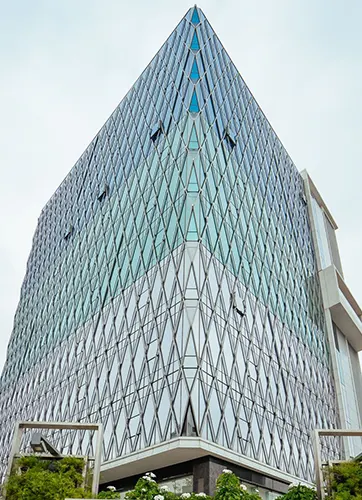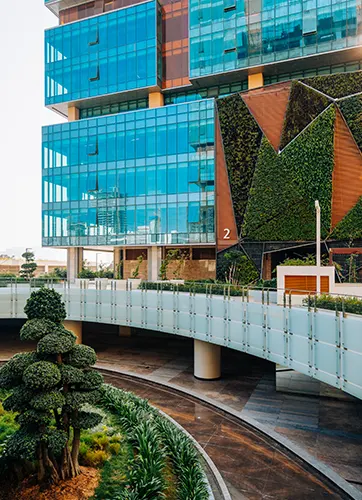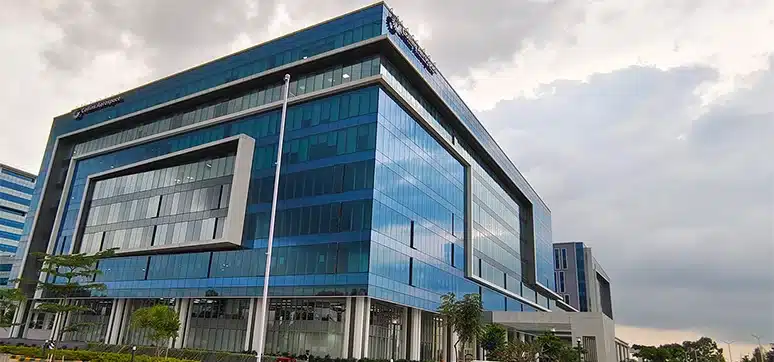What are the advantages of glass façades in high-rise buildings?
- Aesthetics: Glass façades are visually appealing and can create a clean and sleek look for high-rise buildings. They can also be used to create unique shapes and structures that would not be possible with traditional building materials. The transparent nature of glass allows a building’s interior to be visible from the outside, which can add to the aesthetic appeal of the building.
- Natural light: Glass façades allow daylight to enter the building, making it more airy and bright, reducing the need for artificial lighting during the day. This can result in energy savings and a more pleasant indoor environment for building occupants, which is the need of the hour. This can help to reduce energy costs, improving the overall mood of people working or living in the building.

- Views: High-rise buildings with glass façades provide panoramic views of the surrounding area. This enhances the experience of being in the building, especially in areas with scenic views. The transparent nature of glass allows for the outside and inside of the building to be visible, which can be particularly beneficial in urban settings where people may not have access to outdoor space.
- Energy efficiency: Modern glass façades are designed to be energy efficient. They can help to reduce heat gain in the summer and heat loss in the winter, which can result in lower energy costs.
- Sustainability: Glass façades can be made from recycled materials and are themselves recyclable. They can also be designed to maximise natural ventilation, reducing the need for air conditioning systems and further reducing the building’s environmental impact.
- Increased property value: Glass façades add to the look & feel of a building, making it more attractive to potential buyers or tenants.
What are the different types of glass façades and the best type of glass for each considering the type of project?
- Unitized curtain wall: Unitized curtain wall systems are pre-fabricated in a factory and installed on-site. They are made up of glass panels, framing, and other components. The best type of glass for unitized curtain walls is usually Low-E glass, which is designed to reduce heat gain and provide insulation.
- Semi-unitized curtain wall: Semi-unitized curtain wall systems are a hybrid between stick and unitized systems. They are assembled off-site but have some elements that are installed on-site. The best type of glass for semi-unitized curtain walls is laminated glass, which provides enhanced safety and security.
- Stick glazing: Stick glazing is a traditional method of glass façade installation where individual glass panels are installed on site. The best type of glass for stick glazing is tempered glass, which is more durable and resistant to breakage.
- Point-supported glass façade: Point-supported glass façades are suspended from cables or rods attached to a building’s structure. The best type of glass for point supported glass façades is tempered or laminated glass, which is designed to withstand the stresses of being suspended.
- Double-skin façade: Double-skin façades are designed to provide additional insulation and reduce energy consumption. The best type of glass for double-skin façades is Low-E glass, which provides thermal insulation and reduces solar heat gain.
How can glass façades be designed to meet specific performance requirements such as thermal insulation, sound reduction, and solar control?

- Choosing the right glass type: There are various types of glass available in the market, each with its unique properties. For example, Low-E glass is designed to minimise heat transfer, while laminated glass is excellent at reducing sound transmission. Selecting the right glass type for the specific performance requirement is crucial according to me.
- Selecting the right coating: The coating on the glass can significantly impact its performance. For example, reflective coatings are ideal for reducing heat gain and glare, whereas tinted coatings can minimise the amount of sunlight that passes through the glass.
- Using double- or triple-glazed units: Multiple-glazed units offer better thermal insulation and sound reduction. For example, triple-glazed units are more effective at reducing sound transmission compared to single-glazed units.
- Incorporating shading devices: Shading devices like louvers, overhangs, and screens can help control solar heat gain and reduce glare.
- Optimise the façade design: An optimized façade design can improve the overall performance of the glass. For example, designing a façade with high-performance materials and an efficient framing system can significantly improve energy efficiency.
- Use software tools: Various software tools are available to aid in the design process. These tools can simulate the performance of the façade and help identify areas where improvements can be made.
What are the issues associated with glass façades?
- Energy consumption: They can increase energy costs by allowing heat to escape during the winter months and by letting in too much sunlight during the summer months, which can cause the building to become too hot. : Glass façades can significantly increase the energy consumption of buildings by increasing the cooling and heating loads. This can result in higher energy bills and increased carbon emissions. To mitigate this issue, the use of low emissivity glass, double-glazed or triple-glazed windows, and shading devices can be used to reduce the amount of heat gain and loss.
- Cost: Glass façades can be expensive to install and maintain, especially if they are designed with custom shapes and sizes.
- Maintenance: Glass façades require regular cleaning and maintenance to keep them looking their best. This can be time-consuming and expensive, especially in areas with harsh weather conditions.
- Privacy: Glass façades can make it difficult to maintain privacy, particularly in urban areas where buildings are close to each other. This can be a concern for people who work or live in the building and can lead to the need for additional privacy measures, such as curtains or blinds.
- Heat island effect: Glass façades can contribute to the urban heat island effect by absorbing and re-emitting heat. This can lead to increased energy consumption and discomfort for occupants. To mitigate this issue, the use of reflective coatings and shading devices can reduce the amount of heat absorbed by the glass façade.
- Bird collisions: Glass façades can be a hazard for birds as they can mistake the reflection for open space and fly into the glass, causing injury or death. To mitigate this issue, the use of bird-friendly glass, bird diverters, and external shading devices can be used to reduce the risk of bird collisions.

- Waste generation: The production and disposal of glass façades can contribute to the generation of waste and associated environmental impacts. To mitigate this issue, the use of recycled glass and the adoption of sustainable manufacturing practices can reduce the environmental impact of glass façade production.
- Life cycle analysis: A comprehensive life cycle analysis of glass façades should be conducted to assess the environmental impact of the façade over its entire life cycle, including production, transportation, installation, maintenance, and disposal. This can help identify areas for improvement and guide the development of sustainable design strategies.
Brief on the type of glass façade that you like to design or see in the future.
Double skin façade, which consists of two layers of glass separated by an air gap. This design provides improved insulation and energy efficiency, as well as noise reduction and improved indoor air quality.
Biophilic façades – Green façades that integrate nature into the façade.
Dynamic façades can change in response to their surrounding environment, hence Maximizing their performance.
Smart glass – There are also emerging technologies and materials that may shape the future of glass façade design, such as smart glass that can switch from clear to opaque, self-cleaning glass, and glass that can generate electricity through photovoltaic cells.
How do you keep updated on the latest glass products and technologies available in the market?
- I regularly scan news and industry publications related to glass & façades, such as Glass Magazine, Glass International, and Window and Façade Magazine.
- Conferences and trade shows: I keep track of the major conferences and trade shows related to glass. I also keep an eye on the virtual events that have emerged recently due to the COVID-19 pandemic.
- Manufacturer websites and social media: I monitor the websites and social media pages of major glass manufacturers to stay informed about their latest products and technologies. Manufacturer websites and social media: I monitor the websites and social media pages of major glass manufacturers to stay informed about their latest products and technologies.














